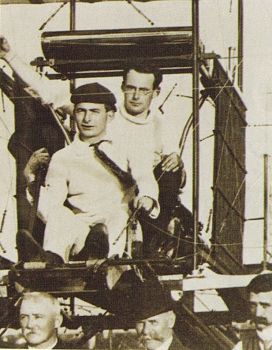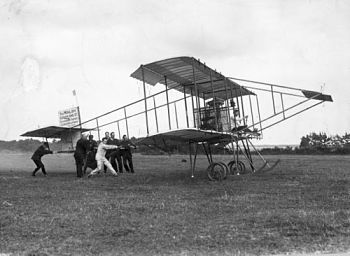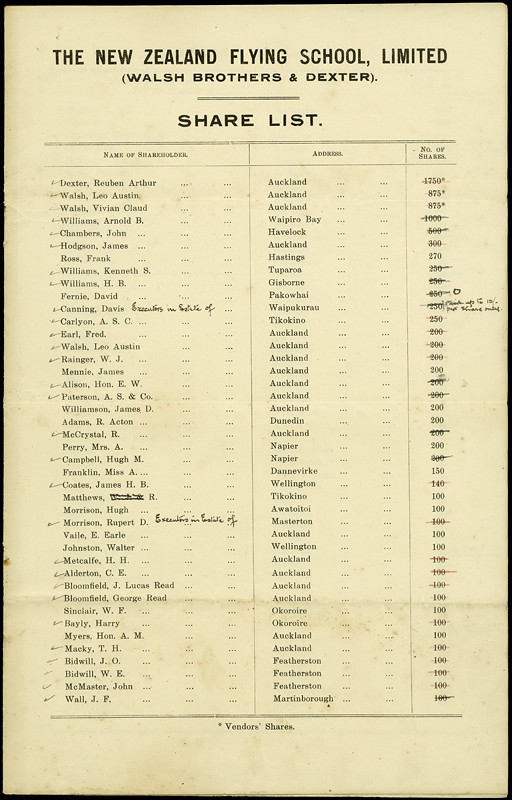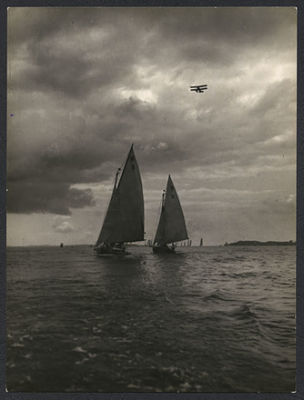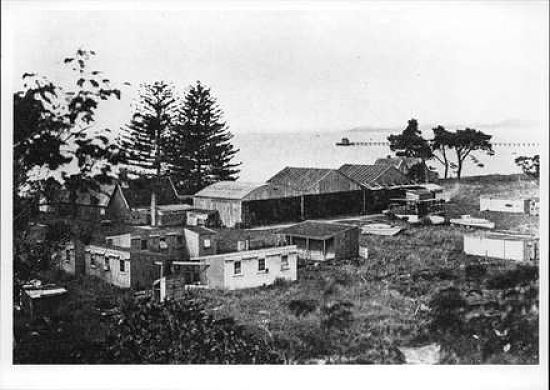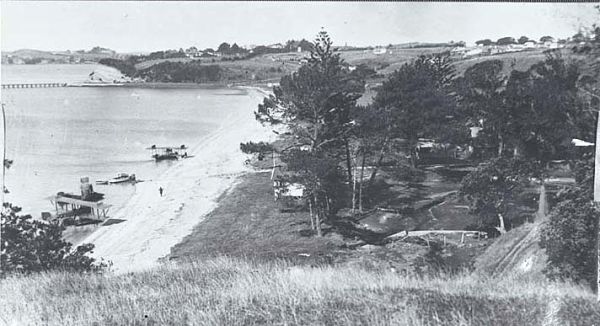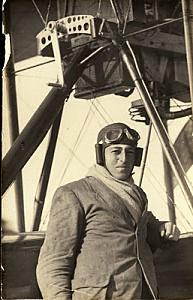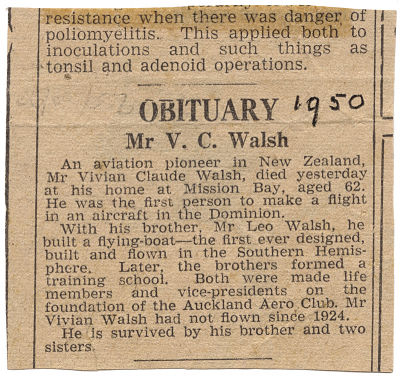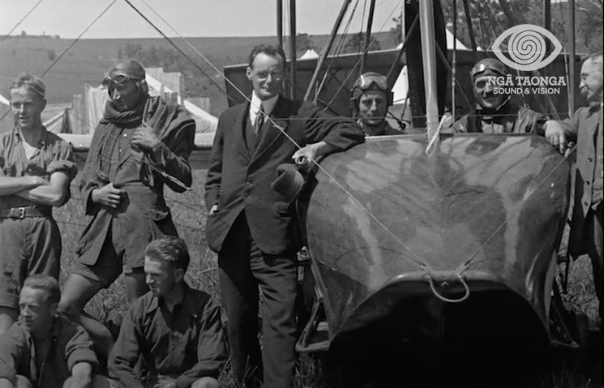The Walsh Brothers – Leo and Vivian
Leo and Vivian Walsh lived in Remuera in Orakei Road with their father Austin and sisters, Veronica and Doreen (their mother Jane died in 1904). They were foundation pupils at King’s College on Remuera Rd in 1896. [1] Vivian became the first New Zealander to receive a pilot’s certificate.
With their father, they established a mechanical engineering and motor importing business in Auckland. Fascinated by accounts of aviation experiments in Europe and America, with other enthusiasts they formed the Aero Club of New Zealand in 1910. The brothers were determined to build and fly an aeroplane and succeeded in obtaining financial backing from Auckland businessmen A.N. and C.B. Lester and A.J. Powley.
They then bought the plans for a British Howard Wright biplane together with materials and an eight-cylinder engine worth about £750 in total. It took about 5½ months for the brothers to manufacture and assemble the aircraft at their family home in Remuera. They were helped by fellow enthusiasts, and their sisters Veronica and Doreen, who machine-sewed hundreds of yards of material for the wings. The finished aircraft, named the Manurewa No 1 bore an inscription “The Walsh Aeroplane Co. Aeronautical Engineers Constructors Auckland.” Beneath this was a crest and the words “Aero Club New Zealand”. [2]
The Manurewa was dismantled and transported to Glenora Park, a private racecourse at Papakura, where it was reassembled for flight. Vivian was the first to fly the plane, and, being careful, made several taxiing tests on the ground before his first successful flight of about 400 yards at a height of 60 feet in early February 1911. The flight was witnessed by a small group of local residents, Aero Club members and a proud family, and was to be followed by many more. Vivian kept detailed records and gradually built up knowledge of the controls and performance of the aircraft. Leo did not attempt to fly the plane as he feared his reactions were too slow, but he was a skilled designer and organiser. The brothers’ different talents made them a formidable team.
The business syndicate, displeased with Vivian’s seemingly excessive caution, took possession of the Manurewa; soon after, it was crashed and damaged beyond repair. Recovering from this setback, Leo, with Vivian’s help, began to design a flying boat of the American Curtiss type which he thought would suit New Zealand conditions. The brothers gained the financial and practical assistance of R. A. Dexter, an American engineer and motor dealer in Auckland, who was to be a consistent supporter.
After more than a year in construction, the new aircraft was completed in November 1914 and transported to Bastion Point on the Waitemata Harbour. Here Vivian took it for its first flight on 1 January 1915. It was the first flying boat designed and built in the southern hemisphere and proved a great success. In March 1915 Vivian took the first of many passengers on a flight of five miles.
When WW1 broke out, the Walsh brothers asked the New Zealand Government for help with training pilots but were refused. However, a signal was sent to the Imperial Government in England asking whether New Zealand trained pilots would be acceptable to the Royal Flying Corps (RFC), and what qualifications they would require. The British Government replied that all suitable candidates qualifying for the Royal Aero Club’s certificate in New Zealand would be accepted for commissions in the RFC and asked that as many candidates as possible should be sent immediately.
The New Zealand Flying School was formed by Leo and Vivian and began training pupils in October 1915. Headquarters were established first at Orakei with “one home-built flying boat and one self-taught instructor”. In August 5 acres (later extended to seven) at the western end of Kohimarama were leased from the Melanesian Mission Trust, allowing the flying school to expand considerably in 1916. Hangars were built facing the beach with rails leading down to the water for launching the flying boats. The brothers and their sisters lived in the former ‘captain’s house’ at the eastern end of the bay, the trainee pilots being accommodated in a row of tents and then wooden huts. [3]
The Walsh brothers sometimes called it the Kohimarama Flying School as the area was called that pre- & during WW1. It wasn’t till after WW1 that the name Mission Bay came into being for the area we know today – the Mission School closed in 1924. Tamaki Drive was not built until the 1930s.
Leo Walsh was managing director, Vivian Walsh was chief pilot and superintendent, R. A. Dexter was director and Austin Walsh was secretary. Both Doreen and Veronica Walsh were involved in the practical running of the school. As well as providing flying instruction, the school built and maintained aircraft, so various other staff including engineers and mechanics were taken on. Some ex-pupils later became flying instructors. The Walsh’s devised a six month training course in flying boats at Mission Bay. 110 men did the course and 68 qualified for the RFC, Royal Naval Air Service (RNAS) or Royal Air Force (RAF, from 1 April 1918). They were the middle class sons of N Z doctors, lawyers, engineers, businessmen & farmers. It was quite appealing to men who wanted a commission and who didn’t want to go into or return to the trenches.
In February 1916 the school gained Imperial recognition which brought with it the official involvement of the New Zealand Defence Department, and elements of military training were incorporated into the school’s programme. The first pilot’s certificate was issued to Vivian Walsh on 13 July 1916. The school obtained its second aircraft in November 1915 and other planes, including the first two Boeing float planes constructed, were acquired later. Over 100 pilots were trained during the war; most saw combat and many gained honours and decorations. The most famous was Keith Logan Caldwell, one of the original three pupils. [4]
Six Remuera men obtained their Royal Aero Club Certificate (like a private pilot’s licence today) but all met a tragic end. Three were killed in air accidents, two on air operations and one at the Battle of the Somme. Air accidents were extremely common – those pilots lost in air accidents between 1915 and 1942 formed one-third of the total of those who died flying. One of those was Trevor Alderton of Remuera.
Vivian, who had set high standards for training, was forced to give up flying in 1919 because of ill health and instead helped Leo to manage the school. At the end of the war it seemed that the New Zealand Flying School might no longer be needed, but the Bettington Report (1919) on aviation recommended that this and the Canterbury (NZ) Aviation Company’s flying school be maintained. In 1920 the government voted £25,000 to keep the schools in existence, but only a small proportion of this was advanced to the New Zealand Flying School.
Very soon the financial burden of operating the flying school became onerous. Leo and Vivian Walsh struggled to keep the school in existence by offering pleasure flights and undertaking charter work. By 1923 they had exhausted their resources and asked the government to take over the school. In October 1924 the government bought the assets of the New Zealand Flying School for about £10,500 – insufficient, Leo Walsh noted, to give any return to shareholders in the venture. Bitterly disappointed, Leo and Vivian Walsh gave up all involvement in aviation and returned to their engineering business, which from the late 1920s was located in Hobson Street, Auckland. Vivian died on 3 July 1950 and Leo on 16 July 1951; neither had married.
While the brothers received no official recognition during their lives, in 1952 the Auckland Branch of the New Zealand Division of the Royal Aeronautical Society initiated the Walsh Memorial Fund to further the interests of aviation and to perpetuate the names of two aviation pioneers. MOTAT also named its library the Walsh Memorial Library, having been set up in 1964 with support from the Walsh Memorial Trust and the Royal Aeronautical Society. [4]
There is an extensive biography of Leonard and Vivian Walsh in the Dictionary of New Zealand Biography on Te Ara – the Encyclopedia of New Zealand, by Terry Moyle and updated by him in 2022. Read more here.
AUCKLAND FROM THE SKIES (movie)
This film shows scenes from Leo and Vivian Walsh’s Flying School at Mission Bay, Kohimarama, Auckland [on 16th & 17th February, 1917]. The New Zealand Flying School opened in 1915 at Orakei before shifting to Mission Bay. It provided trained pilots for the Royal Flying Corps during World War One. Hugh Blackwell and the legendary George Bolt were among the pilots who trained there.
The film shows amazing footage of men training to fly seaplanes at Mission Bay in Auckland. The airmen include George Bolt. Aerial footage includes that of the Waitemata Harbour, Mechanics Bay and Rangitoto. The men attend classes and perform callisthenics outside, train in Morse code and aircraft maintenance. In their spare time they enjoy swimming and water skiing around the Orakei wharf.
Source: Nga Taonga Sound & Vision, 1918, Reference number F7556
